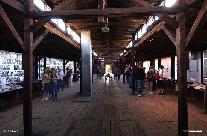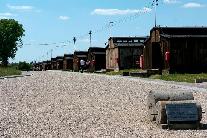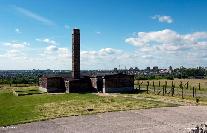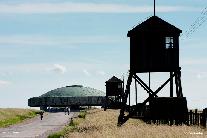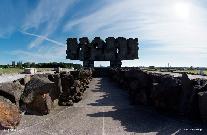EUROPE
State Museum at Majdanek (Poland)
(Feb. 25, 2011)
by Lukasz Myszala, Visitor Service Centre
History:
The German concentration camp in Lublin, popularly called Majdanek, was initiated by Heinrich Himmler’s decision. Visiting Lublin in July 1941, Himmler entrusted Lublin district SS and police commander, Odilo Globocnik, with building a camp “for 25-50,000 inmates who would be used to work in SS and police workshops and at construction sites”. The camp was going to be the source of a free workforce for the realization of the plans to build a German empire in the east.
The camp at Majdanek was subordinate to the Concentration Camps Inspectorate (Inspektion der Konzentrationslager), and from March 1942 to the Economics and Administrative Department of the SS (SS-Wirtschafts- und Verwaltungshauptamt). The camp was administered by a commandant supported by a garrison of up to 1,200 people. The function of the commandant was performed respectively by: Karl Koch, Max Koegel, Hermann Florstedt, Martin Weiß, and Arthur Liebehenschel.
The camp, built from autumn 1941, was initially called Kriegsgefangenenlager der Waffen SS Lublin – a camp for prisoners of war, and in February 1943 was renamed Konzentrationslager Lublin – a concentration camp. The official functions of a POW camp and concentration camp did not exhaust the tasks allocated to Majdanek by the German authorities. Konzentrationslager Lublin was also a link in the realization of the “Final Solution of the Jewish Qestion". In addition it was used as a penal and transit camp for the Polish rural population.
The camp, situated in the south east suburbs of Lublin on the road to Zamość and Lwów, occupied an area of 270 ha. It consisted of three sectors: the SS segment, the administration section and the prisoner area (Schutzhaftlager), which was made up of five so-called “fields” with wooden barracks as the accommodation for inmates. Due to their primitive, careless construction, lack of basic sanitation and the fact that they were overcrowded, the barracks had a negative effect on the conditions of the prisoners’ existence and caused the growth of the death rate in the camp. The situation was even made worse by the shortage of water, food, clothes and medicines. A distinct improvement in the living conditions took place only at the end of the existence of Konzentrationslager Lublin. From October 1942 a camp for women was established in one of the fields. Although the plan to create a camp for children at Majdanek was never realized, Jewish, Belarusian and Polish children from Zamojszczyzna were prisoners of the camp. On the grounds of Konzentrationslager Lublin there was also a field hospital for Soviet disabled soldiers. Majdanek additionally had a few sub-camps (in Lublin on the grounds of the former Plage-Laśkiewicz airport and in Lipowa Street, plus the labour camps in Budzyń, Radom, Bliżyn and Warsaw).
Prisoners came from nearly 30 countries. Polish citizens dominated (mainly Poles and Jews) but there were also prisoners from the Soviet Union and the Czech Republic (Jews). Apart from Poles and Jews, the Russians, Byelorussians, and Ukrainians constituted the largest groups of inmates. Representatives of other nationalities made up a small percentage of the general number of inmates ( French and Germans among others).
From the very beginning of their stay at the camp, the prisoners were inevitably accompanied by hunger, fear, backbreaking work and diseases. For all real and imagined offences prisoners were severely punished and persecuted. Prisoners’ lives were constantly threatened. They died in the aftermath of wretched living conditions, they were executed and murdered in gas chambers. Among an estimated 150,000 prisoners who entered Majdanek, 80,000 people, including 60,000 Jews, were killed according to the most recent research. In order to remove the traces of the crimes, the corpses of those who died and the murdered were burnt on pyres or in the crematorium.
The tragic history of the Lublin concentration camp came to an end on 23rd July 1944 after the Red Army entered the city. Soon, a Soviet NKWD camp was organized for members of the Polish Secret State on the grounds of Majdanek. Germans soldiers were also imprisoned for some time in the barracks of the former camp.
The Museum:
The State Museum at Majdanek was founded in November 1944 on the grounds of the former German concentration camp. It is an institution directly subordinated to the Ministry of Culture and National Heritage. In addition to organizing exhibitions, the museum also runs educational and academic activities. Since 2004 there has also been a non-local branch of Majdanek – Museum – Memorial Site in Bełżec.
The mission of the Museum is to cultivate the memory and promote historical education about the German occupation in the Lublin region during World War II, particularly by means of commemorating the victims, preserving the relics and documenting the history of the concentration camp at Majdanek and the death camp in Bełżec.
Address: ul. Droga Męczenników Majdanka 67
20-325 Lublin, Poland
Phone: +48 81 710 28 21
Homepage: http://www.majdanek.eu/
Days closed: The permanent historical exhibition, artistic installation "Shrine" and the Visitor Service Centre are closed on Mondays, the New Year, Easter Sunday, Easter Monday, May 1st and 3rd, the first day of Pentecost, Corpus Christi, August 15th, November 1st and 11th, 25th and 26th of December. On November 1st all the historical buildings are closed, too.
Admission: Free
(Originally published on February 21, 2011)
 Peace Museums of EUROPE
Peace Museums of EUROPE
